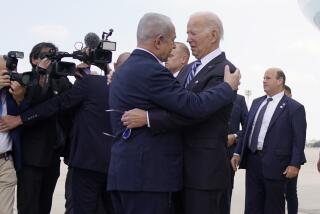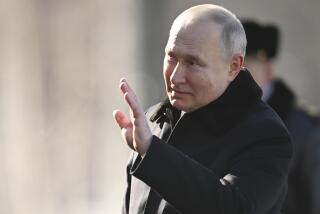Bush’s Bombshell: Now for the Hard Part : Moscow might prove an easier sell than Congress
By boldly moving to deactivate a significant part of the U.S. tactical nuclear arsenal, President Bush is taking not a military but a political gamble. Bush is betting that the Soviet Union will respond in kind by scrapping many of its 27,000 nuclear warheads and by dropping plans to build new weapons and delivery systems. And he is wagering that his dramatic proposals will forestall Democratic-led efforts in Congress to cut far more deeply into future defense budgets. Bush is especially concerned about protecting such controversial big-ticket projects as the B-2 bomber and the Strategic Defense Initiative.
The outlook now--and it is not all that surprising--is that the President may enjoy greater success in Moscow than on Capital Hill.
MOSCOW’S AIM: The Soviets have welcomed Bush’s plan and say they are ready to talk about reciprocity. They are also eager to expand the agenda to embrace a halt to underground nuclear testing and to having the British and French nuclear arsenals made a part of the arms-cutting process. What is yet to be revealed is whether Moscow will go as far as Washington hopes in slashing its short-range nuclear arsenal. The United States will pull thousands of tactical nuclear warheads out of Western Europe, because the threat they were put there to deter--a Soviet invasion--is no longer seen as credible. The Soviets, with their heavy reliance on land-based nuclear weapons, would have to eliminate about four times as many short-range warheads to match the U.S. step. Some in the Soviet military may balk at that prospect.
A feeling nonetheless grows that the door to major cuts in weapons and forces may now stand more open than ever. Lending urgency is the problem of ultimate control over the nuclear weapons stationed in four of the Soviet republics. One way to defuse that problem is by eliminating many of the weapons involved. At the same time a Soviet government desperate for Western economic and technical help can be expected to see with great clarity the political virtues of shedding redundant nuclear weaponry. Arms cuts of the kind that once took years to negotiate may soon be put on a faster-than-ever timetable.
CONGRESS’ GAME: But cuts in arsenals and defense budgets don’t depend entirely on bilateral agreements. The President’s announcement, rather than preempting new congressional pressures to reduce defense spending, may only have encouraged them. Sen. Sam Nunn (D-Ga.), the influential chairman of the Armed Services Committee, underwent a weekend conversion and now thinks that far fewer than the 75 B-2 bombers he earlier believed necessary for the nation’s defense in fact need to be built. The Star Wars program is another that seems certain to be cut back; so, too, plans for a new multibillion-dollar line of attack submarines and the new F-22 fighter. Finally, calls are increasing for more sweeping reductions in U.S. troop levels in Europe and South Korea.
Two considerations animate Congress. One is the radical change in the international strategic equation, now acknowledged so dramatically by the President. The other is a growing insistence that the end of the Cold War should rightfully produce a peace dividend in the form of a big cut in defense spending. The key questions are where and how soon should those cuts be made? A military build-down of considerably greater scope than what was envisaged just a few months ago now tempts many in Congress. But care must be taken. The imprudent and wasteful expansion of defense budgets in the 1980s must not give way to imprudent and dangerous defense budget cuts in the 1990s. The decisive considerations, as always, must be the nature of the military threats facing the United States and its allies around the globe. Realistically defining those threats is the key to future defense spending.
More to Read
Get the L.A. Times Politics newsletter
Deeply reported insights into legislation, politics and policy from Sacramento, Washington and beyond. In your inbox three times per week.
You may occasionally receive promotional content from the Los Angeles Times.










